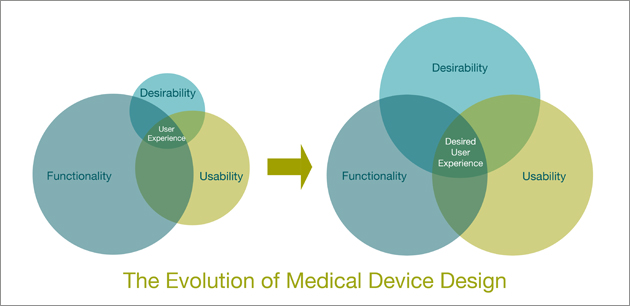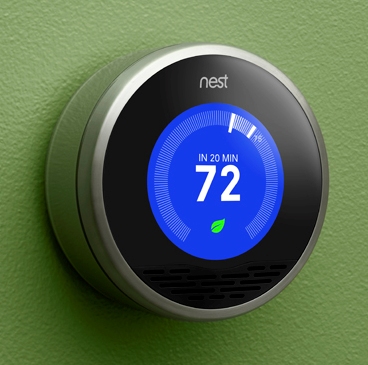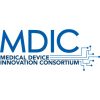The medical device market has changed drastically. The speed of this evolution will only accelerate in the years to come. Medical device executives who recognize these changes, and learn from consumer products companies will drive success for their businesses.
Two forces are driving medical devices to become more like consumer products: patient use and physician expectations. Companies who deliver great user experiences to both these groups will capture market share as they capture their customers’ hearts.
Evolution of experience design
Whether a device is used directly by patients or by medical practitioners, successful product development requires significant focus on creating the right user experience. Far more than the merely human factors, user experience is the fusion of functionality, usability, and desirability. What a product does for the user is its functionality, how a user interacts with it is its usability, and how well the product connects with the user emotionally determines its desirability.

To have any value, a product must perform its function effectively. A product with good usability in addition to functionality improves the user’s experience with clear, understandable ease-of-use. But where products can really set themselves apart is with desirability. Fundamentally, the desired user experience is the harmonization of functionality, usability, and desirability. Great products are those that truly embrace and excel at all three.
A medical device must absolutely perform its base function without fail. So, for good reason, medical device companies have focused on functionality. But efficacy and error reduction aren’t solely dependent upon functionality. Clear, intuitive interaction is vital. This is especially true in the medical world where a device whose operation is complex and confounding not only risks market failure, it risks lives.
This reality has been recognized by FDA regulators, leading to increased regulatory emphasis on human factors design and usability. But that’s where the regulators stop. They don’t care if your product resonates with your customers. They don’t care if your user interface makes users smile. They don’t care if your product looks like an East German tank and tells all the patients’ friends and neighbors how sick they are. The regulators care that it works and that it is safe. This is important, but it’s not the whole story. Since they’re necessary for FDA certification, functionality, and usability are table stakes for market introduction. But in today’s increasingly competitive marketplace, they will not ensure success.
This is where lessons from consumer product companies can help medical device manufacturers distinguish their products and their brands. Companies like Apple, Nike, and Sony provide the template for creating great user experiences by delivering desirability to entice buyers to pick their products off of the shelf, and then follow through their promise through the terrific usability and functionality. Great products don’t just fulfill user expectations, the redefine them.
Going beyond wants and needs
Today, more and more medical devices are being used directly by patients themselves. Some of these products are crossovers (like FitBit and Jawbone’s Up Band) that live with one foot in the medical world and one in the consumer world. Many are straight-up medical products (e.g. Holter monitors) that allow patients to monitor key vitals in order to provide critical data for their doctors.
Others, like insulin pumps, allow patients to participate directly in their own care. Whatever the context, we must understand that patients don’t want to lug around a clunky piece of “medical equipment.” They don’t want any medical device to limit or define them in any way. It can’t shout “patient,” because that label carries with it the not-so-subtle subtext that one is “less than.” Less than healthy. Less than normal.
Desirability is that critical part of the experience equation that turns a user experience from one that gets the job done yet diminishes the spirit, to one that makes patients truly feel better. Not just physically better, but better emotionally, as well.
 Physician expectations
Physician expectations
In truth, consumer thinking can benefit the makers of nearly every kind of medical device. Whether the end user is a physician, nurse, or patient, their expectations are based on experiences in the consumer world. A doctor armed with an iPhone and driving a BMW can’t help but feel disappointed by medical products that miss the boat on desirability.
And if you doubt that desirability can be a game changer for products that at first blush are all about functionality, take a look at Nest. This new home thermostat redefines what a thermostat can be. As a smart, wifi-connected device, it programs itself based on user behavior in order to save energy and money. It raises the bar on functionality, changes the paradigm on usability, and brings desirability to an unexpected product space.
It’s exactly this kind of holistic approach to user experience that has made Apple one of the most valuable brands on the planet. They carefully design their packaging, their user interfaces, their online experiences–in short, everything about the customer’s experience with their product, to ensure the customer is having the best experience possible. As a result, users are Apple’s best “advertisers,” telling everyone they know why their Apple product is the best.
Medical device companies that understand these lessons and embrace the entire user experience will become market leaders as they connect with users in powerful ways. This is where the real opportunity lies.







